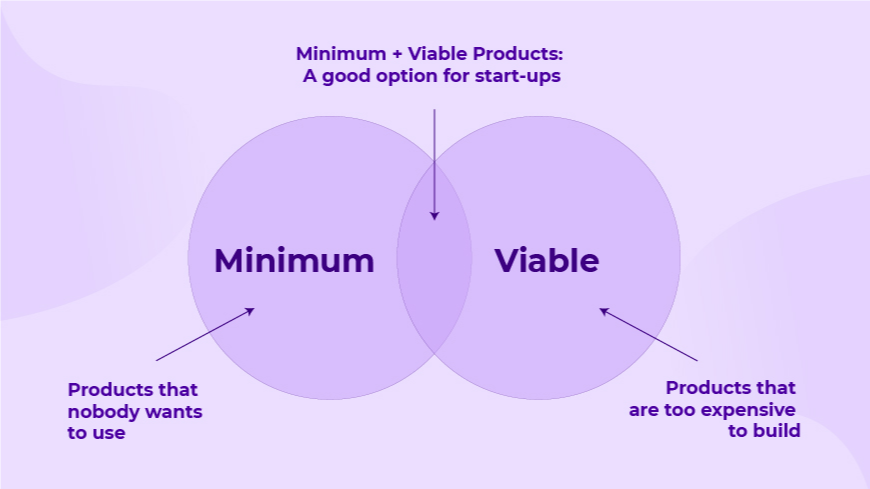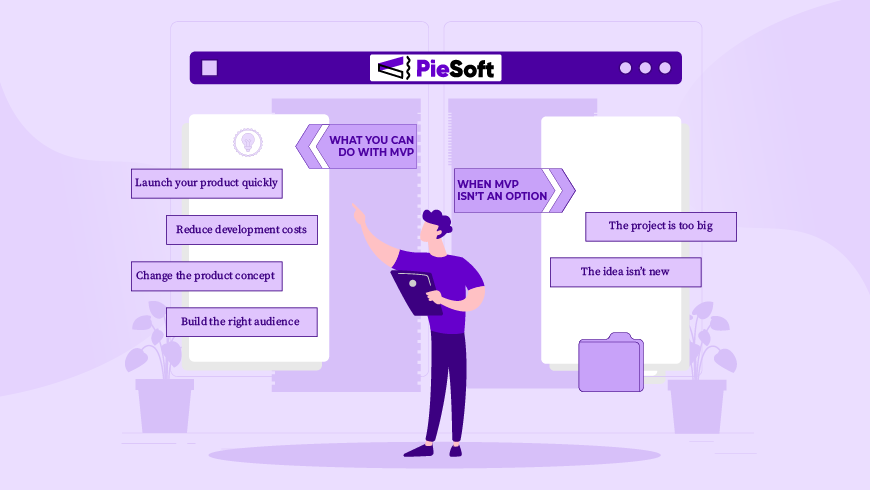Imagine – you have a brilliant, innovative idea for your new software development project. And at an early stage of estimating the budget and time spent, you can tell right away that it will be neither quick nor low-cost. Playing it safe, you are, naturally, looking for a solution that will allow you to ensure the success of your product and build an agile engineering process. Here is where the minimum viable product (MVP) approach steps in to help you determine your next course of action.

What is an MVP?
A minimum viable product is an initial basic version of your future product that allows you to test business ideas and concepts while evaluating the demand efficiently. Two main perks of the MVP in software engineering are its cost-effectiveness and speed of development – usually, it takes around six months to build and deliver it. This approach guarantees you will not spend your budget on an ideal but non-viable project. Producing MVP software or an MVP website, you aim to present a solution with a simple design and minimal functionality that reflects your idea and potentially meets the needs of your target audience. After the launch, you examine the feedback from your first visitors or customers and decide whether it is worth developing the project further or changing some of the core features.
MVP agile development kickstarted the launch of some of the world’s best known products – Facebook, Uber, and Dropbox, to name a few. These MVP examples are role models for modern start-ups and investors. Nowadays, the MVP project is the most appropriate option for a business to test the waters and approach the development process efficiently. Let’s dive deeper and find out why this is the first thing start-ups strive to do when developing their apps.

Why do start-ups use MVP?
Carry out product idea testing
While creating innovative concepts, it’s sometimes impossible to confidently predict how the product will do in the market. Despite any solid business analysis and marketing strategy, pursuing innovations can be erratic, and things can go off the rails due to numerous external factors that are out of your control. To try out the hypotheses with minimum risks and expenses, you can build an MVP with primary functionality that represents the main idea to your potential clients.
Assess the demand for a product
Evaluating the market demand is the main reason start-up entrepreneurs choose MVP software development. Before going all the way and developing a full-fledged solution, it is crucial to clarify how the users perceive your idea right from the start. By gathering reviews from the early adopters, you get essential insights for the further development of your project. After conducting a detailed analysis of the user feedback, you can decide if you want to continue moving in your chosen direction, change some features, or completely rebuild the concept of your software.
Build innovations cost-effectively
Gradual development is key to building a robust and profitable software solution. Starting off with the basic MVP software design, you improve the chances of succeeding at launching your final product version. Get to know your audience step by step, and you will be able to create a top-class product that will skyrocket your sales and brand recognition. And, if the MVP has shown some ineffectiveness in your idea, you will have a clearer picture of what to avoid without losing money on full-scale software development.
Effectively attract investors
No matter how remarkable your business idea sounds, potential investors love real-life numbers and visual representations that verify the reliability of your project. MVP development is the most efficient way to gain their trust from the start. Presenting a seamlessly operating MVP that promises significant profits and is praised by your initial users dramatically increases your chances of receiving investments into your product. Therefore, a successful MVP project and a top-notch pitch are crucial to enhancing your credibility and getting more funds for your start-up.
Launch the product quickly
This aspect strongly affects the cost efficiency of your MVP project and the success of further project development. Competition between the start-ups is fierce, so the primary goal of the software development team is to build your project swiftly for you to enter the market as soon as possible. The developers convey the essence of your innovative idea into a budget-friendly solution and deliver it in 4-6 months from the start of the MVP development.
Still having doubts if you need an MVP, despite its multiple advantages? Well, you may be right. Here are two cases when MVP is not the best option.
Common reasons why this approach will not work
You build the wide-ranging software
When you create a multi-layered product with versatile functionality, it may be impractical to engineer MVP software. In trying to cover all aspects of your diverse IT solution, MVP development can turn out to be expensive, time-consuming, and, as a result, completely wrong for your project. For this particular case, it will be much more effective to thoroughly prepare in the preliminary phase, engineer the architecture and develop a robust product comprehensively.
The idea of the project is not innovative
If you have decided to go with the safe option – a concept successfully tested in your area, industry, or profession – that is a sign you don’t need to develop an MVP website or software. For example, you’re building a food delivery start-up. To stand out in the market, you come up with unique marketing strategies or add some specific positions on the list, but the idea and core concept remains the same as the other food delivery services in your location. In this case, instead of building an MVP, you should focus on other challenges, such as project reliability, creating a unique design, developing an excellent user experience, and effective promotion.

Thus, MVP is essential for every start-up striving to bring an innovative product with a clear focus vision into their industry. Using MVP in software development, you can test ideas, try out new concepts, validate the market fit, attract investors, and save money. Let’s summarize!
The MVP agile development is a game-changing tactic if you want to
- Drastically reduce time to market for initial and further product launches by intensively testing core concepts on MVP;
- Minimize the development expenses by eliminating the possibility of wasting money on unviable project ideas;
- Maneuver the product concept by analyzing the behavior of your early users;
- Find your audience and build their loyalty by forming future product functionality according to customer feedback;
- Enhance the quality of your final product by drawing higher investments into your start-up.
MVP software development is one of the most vital projects for a start-up. At PieSoft, we consider MVP the foundation of your tech journey and engineer your perfect initial software or website solution to help you establish your product in the market.


